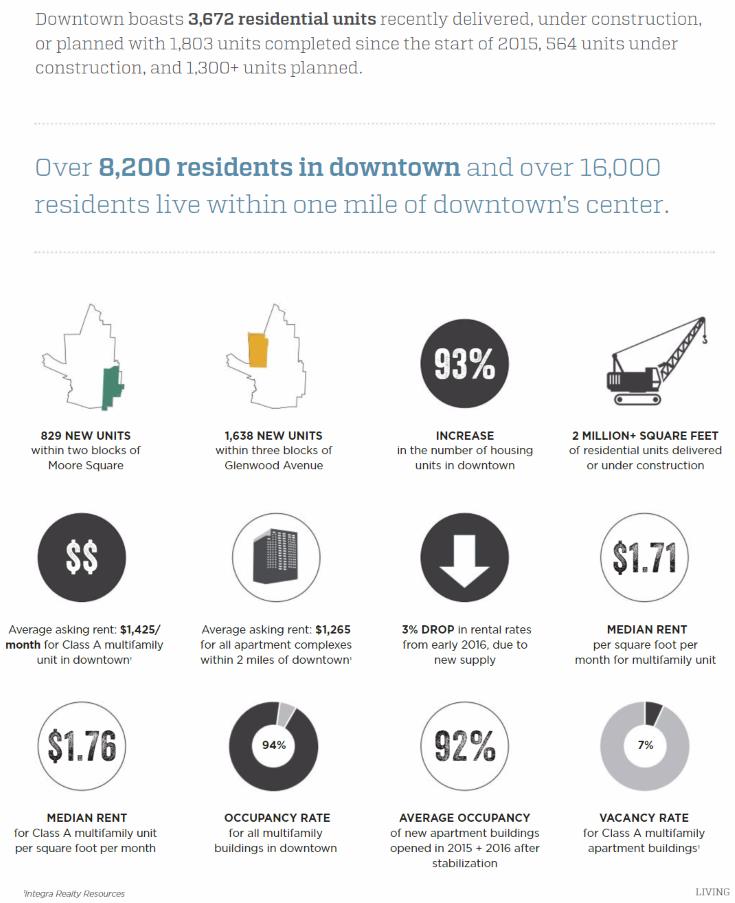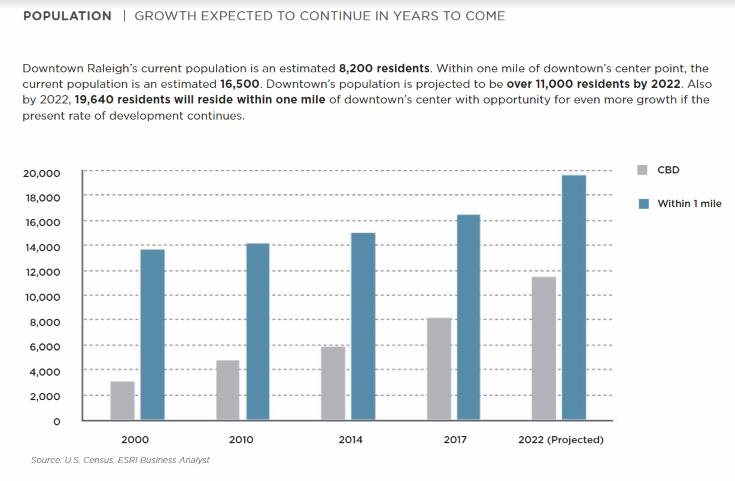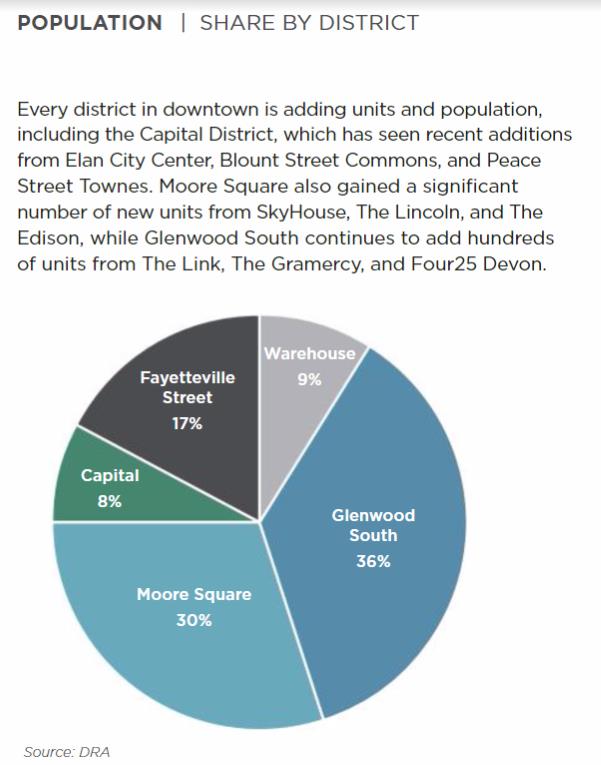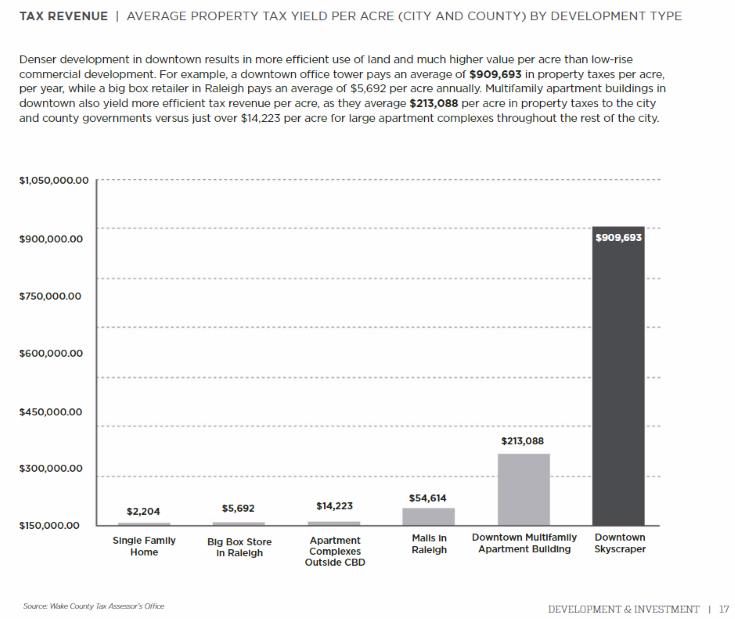Taking a look at more stats from the 2017 State of Downtown Raleigh report, there are a few that cover the residential trends in the area. The graphic above offers some highlights including:
- 8,200 residents now live in downtown Raleigh
- Average asking rent is $1425/month in downtown
- Average asking rent is $1265/month within 2 miles of downtown
- 7% vacancy rate for multifamily apartment buildings
My take on it is that downtown residential is still in high demand and supply is trying to meet it. There are more units on the way which will help meet that demand and bring more residents to the core. The report states that rents are down 3% compared to 2016 so maybe supply is keeping up to a degree.
Predictions on when we cross 10,000 residents?
The chart above projects 11,000 residents by 2022. By then, we’ll have the Capital Boulevard bridge work completed and parts of Smokey Hollow finished. If those projects are very successful, more may follow in that area adding to the resident count around 2022.
The population breakdown by district shows much the same as past years. Glenwood South is the leading home for downtown residents. Recently, Moore Square has had a big infusion of residents with Skyhouse, The Edison, and The Lincoln openings.
I imagine that will continue to be the case between these two areas as the others have less land available for residential. The warehouse district will see an uptick with The Dillon so perhaps this area could have a surge soon.
8,200 residents is still very small compared to the city’s 440,000. We’re talking about 2% of the population. However, in addition to residential projects, the commercial, convention, government, and everything else taking place makes a big impact on the health of our city from a tax point of view.
The revenue generated from downtown projects generate a lot more than those taking place in the suburbs. A dense development needs less stuff from the city; less pipes, less connections, less roads. We therefore get a lot back from it so I like showing this graphic below that a healthy downtown means that the whole city benefits.
Comments
Comments are disabled here. That's because we're all hanging out on the DTRaleigh Community, an online forum for passionate fans of the Oak City.





I agree with everything but the last paragraph. 5401 or Brier Creek installed all the infrastructure at their expense. The City doesn’t extend water & sewer to them it only accepts it for maintenance after a developer installs it to City standards. Downtown projects require larger water & sewer which the City will reimburse based on age, condition, and capacity. Dillon replaced- sewer, Skyhouse- sewer, Gramercy & Links- sewer, and they can be reimbursed from 50-100%. The infrastructure downtown is older & not built to support 20-30 stories buildings. Yes a residential apartment or condo downtown is more tax efficient than a suburb house but downtown also requires ladder trucks for fire (metropolitan) which a suburb house does not. A ladder fire truck cost about a million. Great article as usual Leo.
@ Leo
Another great article, thank you!
Do you know why we call the downtown areas “districts” and not burrows?
Probably influenced from the downtown raleigh alliance and how they break up the area into different districts.
Leo,
Excellent post, you really would be a great asset to the city planning division, you get it!
What about the low income? You are moving them out for your stats. They lived in this area first.
But your right money first!
Clarification:in the downtown area there are three low income affordable housing units for the elderly and disabled …..recently developer have purchased all three. They told them to get out! Where do they go? There’s no affordable housing. What about them?
This is a misplaced perception. What I see happening is the property owner selling and letting leases expire. Blaming developers that buy, and frankly haven’t even shared yet what they intend to do, is nothing but am overreaction.
On a slightly different note, it appears that they have finally erected the construction fence for the One Glenwood office project on Hillsborough st and Glenwood ave. Finally!
@Robert That’s great news! I’m very excited for that project!
One Glenwood is starting? NICE! That establishes a new western border for downtown midrises. That Hillsborough corridor should have several projects going soon…
One Glenwood will be a sweet little project that will have a great impact on this area. Can’t wait to see it go up up up!
I think that it’s time for the city to re-evaluate its DT districts. I can imagine it expanding in all directions. I’d like to see this map: https://www.google.com/maps/place/Downtown,+Raleigh,+NC/@35.7821377,-78.6511113,14z/data=!3m1!4b1!4m5!3m4!1s0x89ac5f1350474ae3:0x6c27d122fcc22910!8m2!3d35.7822393!4d-78.6285252 overlapped with both the district map that the city identifies and the overall DT boundary map to create a new map. It’s interesting that Google considers dt to extend eastward to Raleigh Blvd and northward to the Wake Forest/Capital split and southward to include SouthPark but excludes Glenwood South altogether. It would seem that Google is using train tracks to define the western boundary of downtown. The city’s definition of downtown has a western panhandle that doesn’t show up in a district map at all while excluding Boylan Heights. I could go on but there are lots of inconsistencies on what’s considered downtown.
It seems clear that the city has purposefully excluded single family home neighborhoods from its dt boundary element. Should this be the case?
In any case, if we were to redraw downtown districts, which new ones should be added and what names should we give them? Should some districts just be expanded to include more of their current edges? Should we completely revamp the districts now that we have more than a decade under our belts understanding their connection points and boundaries? For example, does the Warehouse District’s northern boundary remain Morgan or does it functionally extend to Hillsborough St.? Does Glenwood South’s east side really end at Harrington or does it really extend to Capital/Dawson? How might the the new interchange of Capital & Peace + Smokey Hollow affect that in the near future? As more muliti-family comes to the east side of downtown, does Moore Square expand eastward or do we create a new district? Lots of questions……
@John532 you bring up a point that probably does need some attention. The Downtown Raleigh Alliance defines the boundaries of DT based on the area that they serve/cover, understandably. But where does downtown begin and end? What is the difference between ‘Downtown’ and something like ‘Central Raleigh’? Should the term ‘Downtown’ even cover places like Glenwood South and the Warehouse District? Certainly as you move south of Western/MLK or East of Tarboro st, you are no longer Downtown, but it over time those areas may be logical extensions of the central urban area. What do you do with that?
What would it look like if there were several, smaller BIDs for the various districts that would focus on the needs of those places specifically. Then as new ‘Districts’ or neighborhoods begin to form and/or revitalize, those places could have their own BID. Boylan Heights could be its own district. North Person could be one. South Park could have one. Dix View(?) could be one in the future.
Something to think about, I guess…
@David, my take on it is that we don’t take away but add and redefine boundaries. There are actually conflicting signage out there about exactly where the boundaries are for Glenwood South, Warehouse and Capital Districts. It’s really evident when looked at along the Hillsborough/Morgan corridor and the Glenwood South/Capital districts shared boundary.
I also tend to think that DT should include key single family home neighborhoods including Oakwood, Mordecai, Glenwood/Brooklyn, Boylan Heights, South Park and, perhaps, Cameron Park (though that last one is iffy to me). It should also include near east side sfh neighborhoods as far east as Tarboro St. That area is likely to further redevelop in townhouse and edge city low rise multifamily. That’s just my 2 cents.
@John532, you correct John. Just as the Lincoln apartments were a bold step east they are transforming the area east toward Taboro Street. There are more renovations on existing houses in that area and it is great to see. I also think Caraleigh Commons will transform Maywood Avenue and the Dix Park effort. The City needs to add WIDE sidewalks and improve Lake Wheeler Road from Saunders Street to Tryon Road. That will be the best access for walkers/bikes to Dix from DTR versus Boylan & Western as you will not have to deal with race track Western Blvd. The Peace St. bridge & smokey hollow will move the boundary line north so something happens with those ugly warehouse on Capital. FNB tower will add New employees downtown which were not there before. Red Hat running out of room is your best bet for a 30+ tower (Highwood Prop. site?) The One Glenwood project will change and impact Hillsborough & GS and blend into the Warehouse district. Think about it, if you live on Park Avenue you are walking distance to Glenwood South, CV, and little further downtown. Just wait till 301 & 400 Hillsborough Street start….
“Just wait till 301 & 400 Hillsborough Street start…”
That’s all we ever seem to do. Hurry up and wait and wait and wait and wait and wait…
Pam, I wouldn’t worry too much. No one will be kicked to the curb, we live in the era of GoFundMe. I’d assume that the developers and city will be put to task when it comes to seeing that the former tenants are properly relocated.
The developer are chosing not to renew the HUD contract which means they will charge regular rent. If they charge regular rent tenants (elderly/disabled) will be forced to pay or get out. Also, funding for programs like this have been reduced or cut. No one wants to include affordable housing in the revitalization plans for downtown Raleigh. I thought the definition of a community includes everyone.
Affordable housing is a bit of a conundrum. The developer won’t pay top dollar if they know they’re required to build subsidized housing, and of course the current landlord along with the city want people to pay top dollar. Honestly, I’m not sure it makes economic sense to push for affordable housing downtown. Raleigh is like 145 square miles, and downtown is one of the most expensive of those square miles. I can’t afford to live downtown and I don’t think I have a right to either. I do however think the city should do its best to build as much affordable housing as it can (there will never be enough). And I think the city needs to be smart with how it spends that money.
I also don’t know that I agree with that definition of “community”. Lots of communities in places like Greenwich Village or TriBeCa are pretty much all wealthy people. Not every “community” includes every income bracket.
I’m not asking the developer to build affordable housing, however I asking for options for lower income and middle class families. When I said communities I meant Raleigh. I don’t think it’s important for them to live downtown..just give us more options. Build more affordable housing options.
Directly, the city could up their funding. I think they committed for a few hundred units which I think is very low.
Another approach is to get creative with building regulations. Triplexes and even quadplexes seem to be nonexistent in Raleigh these days. (New construction) Allowing these other building types can create more housing for those at the lower end of income spectrum.
Agree Leo. Allowing additional housing types as well as reducing other restrictions (parking minimums, et al) allow the economics to work, reducing the overall cost of housing.
@Pam,
Sorry, I misunderstood. Unfortunately, while the policies espoused by Leo would certainly help, it’s always going to be a struggle for those who need Section 8 vouchers.
Support Wake Habitat for Humanity! They are building 60 homes this year for qualifying families that do not qualify for a traditional mortgage.
Low income housing needs to go hand in hand with a viable transportation strategy in support of it. Many low income and/or elderly residents don’t drive and there needs to be a strategy to assure that these residents are afforded the dignity to not be isolated and culturally stranded. I agree that we don’t owe these residents prime downtown addresses but we do owe them dignity and functioning lives.
I think to be considered Downtown, by definition there has to be a certain level of commercial present. Commercial activity has spread in key areas like Glenwood South and Moore Square but outlying neighborhoods that remain primarily low-density residential should not be considered Downtown.
I’ve sometimes heard these areas in other cities referred to as ‘ring neighborhoods’, ‘fringe neighborhoods’, or ‘greater downtown neighborhoods’. Whatever we call them, defining them could lead to more discussion about their characteristics and opportunities or threats to development.
West of Downtown, development is intensifying in Cameron Village and Hillborough Street (which are clearly not Downtown). This provides unique challenges (or opportunities) to the neighborhoods in between, such as Cameron Park. East of Downtown, there are not as developed walkable neighborhood centers. But there could be. And there are also challenges (or opportunities) there depending on how we envision development taking place here.